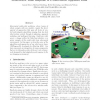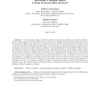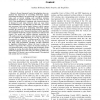516 search results - page 72 / 104 » Motion Planning of Legged Robots |
ICRA
2003
IEEE
14 years 2 months ago
2003
IEEE
Adversarial multi-robot problems, where teams of robots compete with one another, require the development of approaches that span all levels of control and integrate algorithms ra...
TSMC
2002
13 years 8 months ago
2002
This paper proposes a new trajectory generation method that allows full control of transient behavior, namely, time-to-target and velocity profile, based on the artificial potentia...
AR
2004
13 years 9 months ago
2004
-- An inevitable collision state for a robotic system can be defined as a state for which, no matter what the future trajectory followed by the system is, a collision with an obsta...
ICRA
2009
IEEE
14 years 3 months ago
2009
IEEE
Abstract— Recent humanoid control investigations have emphasized the importance of controlling whole-body angular momentum throughout a movement task. For typical movement tasks,...
ROBOCUP
2004
Springer
14 years 2 months ago
2004
Springer
Abstract. This paper describes a behavior-based architecture which integrates existing potential field approaches concerning motion planning as well as the evaluation and selectio...



